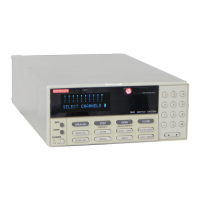IEEE-488 Reference
5-110
These commands are used to program the negative transition (NTR) registers. A negative tran-
sition is defined as a 1 to 0 state change in the condition register. Thus, when an event is pro-
grammed for a negative transition, the appropriate bit in the corresponding event register will
set when the corresponding bit in the condition register changes from 1 to 0. For example, if bit
B1 of the Negative Transition Register of of the Operation Transition Filter is set, then the op-
eration event is programmed for a negative transition. The Set bit (B1) in the Operation Event
Register will set at the end of the relay settling period. For details on register structure, see para-
graph 5.6.
The NTR registers are shown in Figure 5-25B through Figure 5-32B and include the decimal
weight of each bit. The sum of the decimal weights of the bits that you wish to set is the param-
eter (<NRf>) that is sent with the command. For example, to program the Arm (B6) and Trig
(B5) events for negative transitions, send the following command:
:stat:oper:ntr 96
where; Arm (bit B6) = 64
Trig (bit B5) = 32
<NRf> = 96
Effects of negative transitions on the Operation Event Register:
Negative Transition Effect On
Operation Event Operation Event Register
Settling Sets B1 at the end of the settling period.
Trigger Layer Sets B5 when leaving the Trigger Layer.
Arm Layer Sets B6 when leaving an Arm Layer.
Idle Sets B10 when leaving the idle state.
Effects of negative transitions on the Trigger Event Register:
Negative Transition Effect On
Trigger Event Trigger Event Register
Sequence 1 Sets B1 when leaving the Trigger Layer.
Effects of negative transitions on the Arm Event Register:
Negative Transition Effect On
Arm Event Arm Event Register
Sequence 1 Sets B1 when leaving an Arm Layer.
Description
:STATus Subsystem
Artisan Scientific - Quality Instrumentation ... Guaranteed | (888) 88-SOURCE | www.artisan-scientific.com

